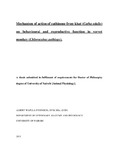| dc.description.abstract | Biological effects of cathinone on behavioural and reproductive functions are inadequately investigated, and available reports in literature are conflicting. A number of these studies have indicated varying degree of information on effect of khat and cathinone on hypothalamo-hypophyseo-adrenocortical axis, mesolimbic system as well as neuro-endocrine disorders and histopathological lesions in testes of humans and experimental animals. This study investigated the mechanism of action of cathinone on behavioural changes in both sexes of vervet monkeys as well as neuro-endocrine alterations that influence reproductive function in males of the same species. The significance of this study was to determine whether cathinone use boosts or is detrimental to reproductive and mental health under varying degree of use. Such information would be vital to social and health care professionals and service providers, as well as policy makers, community-based health groups and international organizations. Fourteen adult vervet monkeys were divided into tests (12 animals) and controls (2 animals), and treated with escalating doses of cathinone at alternate days of each week for 4 months. Controls were administered normal saline in the same pattern as tests. Administration was done via oral gavage. One month of pre-treatment served to establish baseline values. Group II and IV animals were administered GnRH agonist alongside (-)-cathinone two weeks after treatment phase of 4 months. Composite behavioural scores of aggression, anxiety, abnormal responses, withdrawal and appetite loss were done alongside analysis of serum prolactin, cortisol, luteinizing hormone, progesterone and testosterone. Stereology of testicular sub-cellular organelles of Leydig cells was also done following electron microscopy of testicular tissue of the animals. For ex vivo studies, isolated Leydig cells from testis of the animals were co-incubated with luteinizing hormone and subjected to two doses of cathinone (low and
high) overnight at 37 0C. Androstenedione, progesterone and testosterone were analyzed and compared with those in control cells that were treated with incubation media alone. Gene expression of mRNA of hydroxysteroid dehydrogenase enzymes (3 beta- and 17 beta hydroxysteroid dehydrogenase type 1) was done for comparison of results with those of intracellular hormones of testicular cells. Behavioural and hormonal data were analysed for within- and between-subjects effects using Greenhouse-Geisser correction. Separate ANOVAs were performed for each behavioural and hormonal variables with Bonferroni post hoc multiple comparisons using SPSS version 14. Results indicate a dose-dependent effect of (-)-cathinone on behavioural and hormonal profiles. Composite scores of aggression, anxiety, abnormal responses, withdrawal and appetite loss increased in a dose-dependent manner. Serum prolactin, cortisol and progesterone decreased with escalating doses of (-)-cathinone. Serum LH increased with increasing doses while testosterone increased with lower doses and peaked with medium dose then decreased with high dose. The morphological picture showed disruption in smooth and rough endoplasmic reticulum, lipid droplets, mitochondria and Golgi apparatus of Leydig cells, which were either morphologically altered or reduced in number. Morphometric data showed reduced volume densities of these steroidogenic structures. Sertoli cells of treated animals were unaffected while spermatogonia, spermatocytes, spermatids and spermatozoa were variously affected by (-)-cathinone treatment. The effects observed ranged from disruption of cell membranes of spermatogonia, condensation of chromatin material in spermatocytes accompanied by intracytoplasmic vacuolation, disruption of formation acrosome granules in acrosome vesicles and failure of flagella formation at high dose of (-)-cathinone. The mRNA expression of 3 beta- and 17 beta hydroxysteroid dehydrogenase type 1 enzymes increased with low and medium doses but decreased at high dose of (-)-cathinone. The findings demonstrate that sub-chronic exposure
to (-)-cathinone at high dose causes behavioural and hormonal alterations probably via changes in presynaptic striatal dopamine system and hypothalamo-hypophyseal-adrenocortical and gonadal axis integrity. The processes of spermatogenesis and steroidogenesis appear to be affected at high dose of cathinone as evidenced by morphological alterations and suppression of steroidogenic enzyme expression of vervet monkey testis | en |

